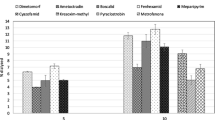Abstract
Twenty-six samples of commercial ice-wine made from late-harvested grapes were assayed for the mycotoxins ochratoxin A and tenuazonic acid. Canadian wines originated in British Columbia (18) and Ontario (8). For comparison two German wines from Hesse were also studied. Four additional samples of research ice-wine originating in were also studied. In all wine samples, assays using immuno-affinity chromatography and fluorescence liquid chromatography indicated ochratoxin A below 0.15 μg/L, the limit of determination of the method. Tenuazonic acid was determined by solidphase micro-extraction and liquid chromatography and was below the limit of determination (70 μg/L) in all samples. The European Union food tolerance limit for ochratoxin A in wine is 2 μg/L. A tolerance for tenuazonic acid has not yet been established.
Similar content being viewed by others
References
Battilani P, Giorni P, Bertuzzi T, Formend S, Pietri A (2006) Black Aspergilli and ochratoxin A in grapes in Italy. Int J Food Microbiol 111, suppl. 1, S2-S4
Battilani P, Logrieco A, Giorni P, Cozzi G, Bertuzzi T, Pietri A (2004) Ochratoxin A production byAspergillus carbonarius on some grape varieties grown in Italy. J Sci Food Agric 84: 1736–1740
Battilani P, Magan N, Logrieco A (2006) European research on ochratoxin A in grapes and wine. Int J Food Microbiol 111, suppl. 1, S53-S60
Bejaoui H, Mathieu F, Taillandier P, Lebrihi A (2006) Black Aspergilli and ochratoxin A production in French vineyards. Int J Food Microbiol 111, suppl. 1. S46-S52
Bellí N, Bau M, Marín S, Abarca ML, Ramos AJ, Bragulat MR (2006) Mycobiota and ochratoxin A producing fungi from Spanish wine grapes. Int J Food Microbiol 111, suppl. 1, S40-S45
European Commission. (2005) Commission regulation (EC) no. 123/2005 of 26 January 2005 amending regulation (EC) no. 466/2001 as regards ochratoxin A. Official Journal of European Communities L25, 3–5
Guzev L, Danshin A, Ziv S, Lichter A (2006) Occurrence of ochratoxin A producing fungi in wine and table grapes in Israel. Int J Food Microbiol 111, suppl. 1, S67-S71
Leong SL, Hocking AD, Pitt JI, Kazi BA, Emmett RW, Scott ES (2006) Australian research on ochratoxigenic fungi and ochratoxin A. Int J Food Microbiol 111, suppl. 1, S10-S17
Monaci L, Palmisano F (2004) Determination of ochratoxin A in foods: state of the art and analytical challenges. Analyt Bioanalyt Chem 378: 96–103
Ng W, Mankotia M, Pantazopoulos P, Neil RJ, Scott PM (2004) Ochratoxin A in wine and grape juice sold in Canada. Food Addit Contam 21: 971–981
Scott PM (2001) Analysis of agricultural commodities and foods forAlternaria mycotoxins. J AOAC Int 84: 1809–1817
Scott PM, Lawrence GW, Lau BPY (2006) Analysis of wines, grape juices and cranberry juices forAlternaria toxins. Mycotoxin Res 22: 142–147
Serra R, Lourenco A, Alipio P, Venancio, A (2006) Influence of the region of origin on the mycobiota of grapes with emphasis onAspergillus andPenicillium species. Mycol Res 110: 971–978
Serra R, Mendonça C, Venâncio A (2006) Ochratoxin A occurrence and formation in Portuguese wine grapes at various stages of maturation. Int J Food Microbiol 111, suppl. 1, S35–39
Smith ER, Fredrickson TN, Hadidian Z (1968) Toxic effects of the sodium and the N,N’-di-benzylethylenediamine salts of tenuazonic acid (NSC-525816 and NSC-82260). Cancer Chemother Rep 52: 579–585
Solfrizzo M, de Girolamo A, Vitti C, Visconti A, van den Bulk R (2004) Liquid Chromatographie determination ofAlternaria toxins in carrots. J AOAC Int 87: 101–106
Tjamos SE, Antoniou PP, Tjamos EC (2006)Aspergillus spp., distribution, population composition and ochratoxin A production in wine producing vineyards in Greece. Int J Food Microbiol 111, suppl. 1, S61–66
Varga J, Kozakiewicz Z (2006) Ochratoxin A in grapes and grape-derived products. Trends Food Sci Technol 17: 72–81
Visconti A, Pascale M, Centonze G (2001) Determination of ochratoxin A in wine and beer by immunoaffinity column cleanup and liquid Chromatographie analysis with fluorometric detection: collaborative study. J AOAC Int 84: 1818–1827
Zimmmerli B, Dick R (1996) Ochratoxin A in table wine and grape-juice: occurrence and risk assessment. Food Addit Contam 13: 655–666
Author information
Authors and Affiliations
Corresponding author
Rights and permissions
About this article
Cite this article
Abramson, D., Delaquis, P. & Smith, D. Assessment of ochratoxin A and tenuazonic acid in Canadian ice-wines. Mycotox Res 23, 147–151 (2007). https://doi.org/10.1007/BF02951511
Received:
Accepted:
Issue Date:
DOI: https://doi.org/10.1007/BF02951511




